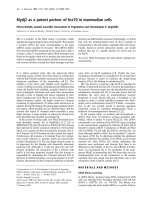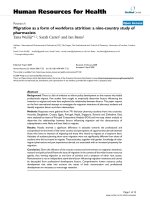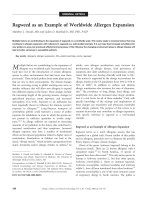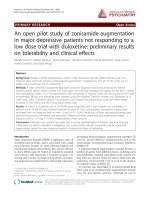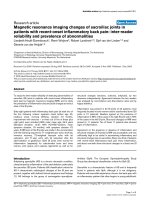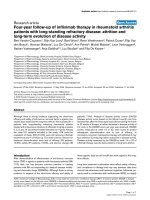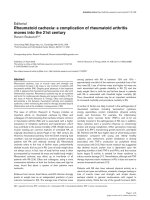Báo cáo y học: " Microfinance as a method of facilitating research in emergency medicine" ppsx
Bạn đang xem bản rút gọn của tài liệu. Xem và tải ngay bản đầy đủ của tài liệu tại đây (275.23 KB, 3 trang )
Hallas et al. Scandinavian Journal of Trauma, Resuscitation and Emergency Medicine
2010, 18:23
Open Access
COMMENTARY
© 2010 Hallas et al; licensee BioMed Central Ltd. This is an Open Access article distributed under the terms of the Creative Commons
Attribution License ( which permits unrestricted use, distribution, and reproduction in
any medium, provided the original work is properly cited.
Commentary
Microfinance as a method of facilitating research in
emergency medicine
Peter Hallas*
†
, Mikkel Brabrand
†
and Lars Folkestad*
Abstract
Microgrants are a novel concept where small grants are used to facilitate research. The concept might have a place in
developing emergency medicine research, especially in countries where emergency medicine is not established or in
new areas of research. Two examples of the beneficial effects of microgrants in emergency medicine research are
described. Emergency medicine interest groups and foundations should consider setting up microgrant schemes.
Microfinance (small loans for minor projects) has been
successfully used for developing small businesses in
developing countries for several years. Microfinance in
the form of "microgrants" has been suggested as a way of
facilitating research projects [1]. In this article we discuss
the possibilities of using microgrants to facilitate research
in emergency medicine and illustrate the concept with
two examples.
The concept of microgrants in facilitating research
Small research projects with minor funding needs are
often met with overwhelming administrative require-
ments when competing for resources. This obstacle can
be difficult to overcome, especially for new researchers
with little or no support from more experienced col-
leagues.
The concept of "microgrants" is to award small grants to
researchers who otherwise would have no access to fund-
ing [1]. Like microfinanance has been used to develop
local business projects in developing countries, research
projects suitable for microgrants should focus on local,
applied health questions. The projects could have imme-
diate benefit for local health and might in the long run
lead to a lasting local tradition of research. Microgrant
initiatives should include support from experienced fel-
low researchers if needed.
Researchers can provide ingenious and innovative
approaches to biomedical research and laboratory diag-
nosis even in the context of very limited resources [2,3].
Limited resources might even create "a creative pressure"
that forces scientists to come up with new procedures
and research methods [2]. However, the concept of
microgrants has been met with worries that the broader
impact of research from microgrants projects might be
limited because of the local focus of the projects [4].
Why use microfinance in emergency medicine
research?
In most countries emergency medicine is still an over-
looked field of research. In Europe some countries (i.e.
Denmark) do not even have emergency medicine estab-
lished as a speciality and many are only beginning to
establish an academic tradition in the field [5]. With aca-
demic traditions only in their earliest development, there
are often limited funding opportunities and few possibili-
ties of support from mentors. Thus, some countries can
be considered to be on a "developing level" as far as emer-
gency medicine is concerned, and it might be prudent to
use the same method to facilitate research in these coun-
tries as in developing countries.
Moreover, few countries have charities that focus primar-
ily on topics in emergency medicine. Charities and foun-
dations often focus on clearly defined diagnostic entities
(e.g. "allergy" or "cardiac disease") and patients in the
emergency department do not always fit into these cate-
gories. Similarly, projects that concern undiagnosed
patients or emergency medicine management issues can
therefore have difficulties securing major funding. A new
concept for facilitating research could possibly help proj-
* Correspondence:
,
The Danish Society for Emergency Medicine, c/o The Emergency Department,
Slagelse Hospital, Ingemannsvej 18. 4200 Slagelse, Denmark
†
Contributed equally
Full list of author information is available at the end of the article
Hallas et al. Scandinavian Journal of Trauma, Resuscitation and Emergency
Medicine 2010, 18:23
Page 2 of 3
ects focusing on these types of issues. Microgrants could
be one of the ways to solve such problems.
Example 1
Microgrant in research uncovering organisational issues
The organisation of emergency care in Denmark has been
debated for years, but many aspects of how emergency
care is organised have not been documented.
We used a microgrant of c. 100 US$ (500 Danish kroner)
to perform a questionnaire about acute admissions to
Danish hospitals.
The grant (provided by the Danish Society for Emergency
Medicine) was used for a gift certificate that participants
could win. Distribution of the questionnaire and collec-
tion of the data was done on-line literally without any
costs.
The project has so far resulted in three publications all
pointing out areas where the quality of care can be
improved:
- Inexperienced doctors routinely treat critically ill
patients with little or no supervision [6].
- There is a gap between guidelines and current practice
regarding interhospital transfers [7].
- Medical admission units in Denmark rarely use triage-
systems [8].
In addition, there has been a significant local impact of
the results with all three articles generating considerable
media attention and political discussions. After the publi-
cation of preliminary results from [7], a Danish charity
has donated 75,000 US$ to an educational programme in
interhospital transfers.
Example 2
Microgrants in the study of rare procedures
Some life-saving procedures are rarely performed in a
normal emergency department, e.g. emergency tracheot-
omy or intraosseous access. Therefore, only a few doctors
get substantial experience with the procedures and even
multicenter studies would have difficulties accumulating
enough data. This makes it difficult to estimate complica-
tion rates and to analyse options for improvement of
design of the devices used.
We e-mailed a questionnaire to emergency medicine phy-
sicians, anaesthesiologists and paediatricians in Scandi-
navia about their experiences with intraosseous access.
The budget of c.100 US$ (500 Danish kroner) was used
for a gift certificate that participants could win. Distribu-
tion of the questionnaire and collection of the data, how-
ever, was done on-line literally without any costs.
This project has resulted in the accumulation of detailed
data on 2995 attempts to place intraosseous cannulas
from a total of 732 Scandinavian health care workers.
Analysis of the data is pending. Having data on so many
attempts of intraosseous access, is seems unprecedented
in the medical literature. We hope that the data can pro-
vide us with clues on how to improve the design of
intraosseous cannula devices and how adherence to
guidelines can be improved.
Perspectives
In both examples a very small amount of money was used
to facilitate important research projects. The grants were
used for gift certificates because monetary incentives
combined with mail and telephone is known to increase
response rates of questionnaires [9]. We are convinced
that the small grants were crucial for the projects.
Possibly microfinance in the form of microgrants like
these could have a similar impact on other small research
projects. Sometimes only a minor amount is sufficient to
get a project going. The money might be essential for
buying modest equipments, renting manikins, printing
booklets, paying publishing fees or (as in our cases) as
incentive for respondents of questionnaires.
Most traditional foundations do not bother to provide
very small grants or require extensive administrative
work regardless of the amount asked for. In addition, it
may be hard to convince institutional donors to offer
microgrants because of the low profile of many of the
projects suited for microgrants [2]. Nonetheless, it could
be worthwhile for established foundations to consider
microgrants as an option where you get comparatively
high value-for-money. Most grant portions might have to
be around 1,000 -2,000 US$. But as can be seen from our
examples, as little as 100 $ could have a substantial effect
as well. National emergency medical societies are recom-
mended also to consider setting up microfinance pro-
grammes of their own. This would enable them to target
microgrants towards specific areas of interest.
Peer support is an essential component of facilitating
research, and microgrant initiatives could therefore
include offers of support from fellow researchers
[1,10,11].
Conclusion
Microfinance in the form of microgrants can be used to
facilitate research in emergency medicine. The concept
could be especially important in countries where emer-
gency medicine is not yet fully developed and for
research in areas that do not receive much attention from
established foundations. Emergency medicine interest
groups, e.g. national societies, should consider setting up
programmes for microgrants.
Author Details
The Danish Society for Emergency Medicine, c/o The Emergency Department,
Slagelse Hospital, Ingemannsvej 18. 4200 Slagelse, Denmark
Received: 13 February 2010 Accepted: 22 April 2010
Published: 22 April 2010
This article is available from: 2010 Hallas et al; licensee BioMed Central Ltd. This is an Open Access article distributed under the terms of the Creative Commons Attribution License ( which permits unrestricted use, distribution, and reproduction in any medium, provided the original work is properly cited.Scandinavi an Journal of Trau ma, Resuscita tion and Emergenc y Medicine 2010, 18:23
Hallas et al. Scandinavian Journal of Trauma, Resuscitation and Emergency
Medicine 2010, 18:23
Page 3 of 3
References
1. MacDonald N, Kabakyenga J: Microresearch: borrowing from the
microfinance experience [editorial]. CMAJ 2008, 179:399.
2. Coloma J, Harris E: Innovative low cost technologies for biomedical
research and diagnosis in developing countries. BMJ 2004,
329(7475):1160-2.
3. Acolet D, Harvey D: Low cost technology for the newborn in developing
countries. Arch Dis Child 1993, 69:477-8.
4. Tang G: Microresearch: great idea but tough to execute. CAJ 2008,
179:931-932.
5. Fleischmann T, Fulde G: Emergency Medicine in Modern Europe. Emerg
Med Australas 2007, 19(4):300-2.
6. Folkestad L, Brabrand M, Hallas P: Supervision of junior doctors and
allocation of work tasks regarding admissions and further treatment of
acute admitted patients. Ugeskr Laeger 2009 in press.
7. Hallas P, Folkestad L, Brabrand M: Level of training and experience in
physicians performing interhospital transfers of adult patients in the
internal medicine department. Emerg Med J 2009, 26(10):743-4.
8. Brabrand M, Folkestad L, Hallas P: Triage in acute medical admission
units. Ugeskr Laeger 2009 in press.
9. Beebe TJ, Davern ME, McAlpine DD, Call KT, Rockwood TH: Increasing
response rates in a survey of Medicaid enrollees: the effect of a prepaid
monetary incentive and mixed modes (mail and telephone). Med Care
2005, 43(4):411-4.
10. Smesny AL, Williams JS, Brazeau GA, Weber RJ, Matthews HW, Das SK:
Barriers to scholarship in dentistry, medicine, nursing, and pharmacy
practice faculty. Am J Pharm Educ 2007, 71(5):91.
11. Edwards K: "Short stops": peer support of scholarly activity. Acad Med
2002, 77(9):939.
doi: 10.1186/1757-7241-18-23
Cite this article as: Hallas et al., Microfinance as a method of facilitating
research in emergency medicine Scandinavian Journal of Trauma, Resuscita-
tion and Emergency Medicine 2010, 18:23

